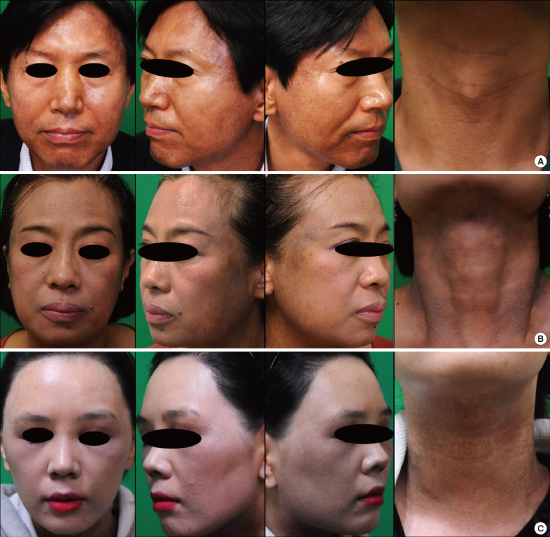1. Pérez-Bernal A, Muñoz-Pérez MA, Camacho F. Management of facial hyperpigmentation. Am J Clin Dermatol. 2000; 1:261–268.
2. Rigopoulos D, Gregoriou S, Katsambas A. Hyperpigmentation and melasma. J Cosmet Dermatol. 2007; 6:195–202.
3. Patel AB, Kubba R, Kubba A. Clinicopathological correlation of acquired hyperpigmentary disorders. Indian J Dermatol Venereol Leprol. 2013; 79:367–375.
4. Khanna N, Rasool S. Facial melanoses: Indian perspective. Indian J Dermatol Venereol Leprol. 2011; 77:552–563.
5. de Souza A, el-Azhary RA, Camilleri MJ, Wada DA, Appert DL, Gibson LE. In search of prognostic indicators for lymphomatoid papulosis: a retrospective study of 123 patients. J Am Acad Dermatol. 2012; 66:928–937.
6. Molinar VE, Taylor SC, Pandya AG. What’s new in objective assessment and treatment of facial hyperpigmentation? Dermatol Clin. 2014; 32:123–135.
7. Grimes PE. Management of hyperpigmentation in darker racial ethnic groups. Semin Cutan Med Surg. 2009; 28:77–85.
8. Gernone A, Frassanito MA, Pellegrino A, Vacca A, Dammacco F. Multiple myeloma and mycosis fungoides in the same patient: clinical, immunologic, and molecular studies. Ann Hematol. 2002; 81:326–331.
9. Kang HY. Melasma and aspects of pigmentary disorders in Asians. Ann Dermatol Venereol. 2012; 139:Suppl 4. S144–7.
10. Lachapelle JM, Maibach HI. The International Contact Dermatitis Research Group. Patch Testing and Prick Testing. 2nd ed. Berlin: Springer;2009.
11. Serrano G, Pujol C, Cuadra J, Gallo S, Aliaga A. Riehl’s melanosis: pigmented contact dermatitis caused by fragrances. J Am Acad Dermatol. 1989; 21:1057–1060.
12. Grimes PE, Yamada N, Bhawan J. Light microscopic, immunohistochemical, and ultrastructural alterations in patients with melasma. Am J Dermatopathol. 2005; 27:96–101.
13. Vega ME, Waxtein L, Arenas R, Hojyo T, Dominguez-Soto L. Ashy dermatosis and lichen planus pigmentosus: a clinicopathologic study of 31 cases. Int J Dermatol. 1992; 31:90–94.
14. Park JY, Kim YC, Lee ES, Park KC, Kang HY. Acquired bilateral melanosis of the neck in perimenopausal women. Br J Dermatol. 2012; 166:662–665.
15. Jung JM, Han JS, Won CH, Chang SE, Lee MW, Choi JH, Moon KC. Pigmented contact dermatitis caused by hydroquinone: an unusual presentation and allergen. Korean J Dermatol. 2015; 53:173–175.
16. Ebihara T, Nakayama H. Pigmented contact dermatitis. Clin Dermatol. 1997; 15:593–599.
17. Calonje E, McKee PH. McKee’s Pathology of the Skin. 4th ed. Edinburgh: Elsevier/Saunders;2012.
18. Rorsman H. Riehl’s melanosis. Int J Dermatol. 1982; 21:75–78.
19. Shenoi SD, Rao R. Pigmented contact dermatitis. Indian J Dermatol Venereol Leprol. 2007; 73:285–287.
20. Li YH, Liu J, Chen JZ, Wu Y, Xu TH, Zhu X, Liu W, Wei HC, Gao XH, Chen HD. A pilot study of intense pulsed light in the treatment of Riehl’s melanosis. Dermatol Surg. 2011; 37:119–122.
21. Chuah SY, Leow YH, Goon AT, Theng CT, Chong WS. Photopatch testing in Asians: a 5-year experience in Singapore. Photodermatol Photoimmunol Photomed. 2013; 29:116–120.
22. Czarnobilska E, Obtułowicz K, Dyga W, Gołuch A, Zwiewka M. Eosinophilia, ECP and Ecp/Eo ratio in allergic and non-allergic diseases. Przegl Lek. 2005; 62:765–768.
23. Lever WF, Elder DE. Lever’s Histopathology of the Skin. 9th ed. Philadelphia, PA: Lippincott Williams & Wilkins;2009.














 PDF
PDF ePub
ePub Citation
Citation Print
Print





 XML Download
XML Download